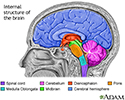Facial tics
Tic - facial; Mimic spasmA facial tic is a repeated spasm, often involving the eyes and muscles of the face.
Causes
Tics most often occur in children, but may last into adulthood. Tics occur 3 to 4 times as often in boys as girls. Tics may affect as many as one quarter of all children at some time.
The cause of tics is unknown, but stress appears to make tics worse.
Short-lived tics (transient tic disorder) are common in childhood.
Transient tic disorder
Provisional (transient) tic disorder is a condition in which a person makes one or many brief, repeated, movements or noises (tics). These movements...

A chronic motor tic disorder also exists. It may last for years. This form is very rare compared to the common short-lived childhood tic. Tourette syndrome is a separate condition in which tics are a major symptom.
Chronic motor tic disorder
Chronic motor or vocal tic disorder is a condition that involves quick, uncontrollable movements or vocal outbursts (but not both).

Tourette syndrome
Tourette syndrome is a condition that causes a person to make repeated, quick movements or sounds that they cannot control.
Read Article Now Book Mark ArticleSymptoms
Tics may involve repeated, uncontrolled spasm-like muscle movements, such as:
- Eye blinking
- Grimacing
- Mouth twitching
- Nose wrinkling
- Squinting
Repeated throat clearing or grunting may also be present.
Exams and Tests
Your health care provider will usually diagnose a tic during a physical examination. No special tests are needed. In rare cases, an electroencephalogram (EEG) may be done to look for seizures, which can be the cause of tics.
Electroencephalogram
An electroencephalogram (EEG) is a test to measure the electrical activity of the brain.

Seizures
A seizure is the physical changes in behavior that occurs during an episode of specific types of abnormal electrical activity in the brain. The term ...

Treatment
Short-lived childhood tics are usually not treated. Calling the child's attention to a tic may make it worse or cause it to continue. A non-stressful environment can make tics occur less often, and help them go away more quickly. Stress reduction programs or cognitive behavioral intervention may also be helpful.
If tics severely affect a person's life, medicines may help control them.
Outlook (Prognosis)
Simple childhood tics should go away on their own over a period of months. Chronic tics may continue for a longer period of time.
Chronic
Chronic refers to something that continues over an extended period of time. A chronic condition is usually long-lasting and does not easily or quick...

Possible Complications
In most cases, there are no complications.
When to Contact a Medical Professional
Make an appointment with your provider if tics:
- Affect many muscle groups
- Are persistent
- Are severe
Prevention
Many cases cannot be prevented. Reducing stress may be helpful. Sometimes, counseling can help your child learn how to cope with stress.
References
Kim JW, Walter HJ, DeMaso DR. Motor disorders and habits. In: Kliegman RM, St. Geme JW, Blum NJ, et al, eds. Nelson Textbook of Pediatrics. 22nd ed. Philadelphia, PA: Elsevier; 2025:chap 37.
Tochen L, Singer HS. Tics and Tourette syndrome. In: Swaiman KF, Ashwal S, Ferriero DM, et al, eds. Swaiman's Pediatric Neurology: Principles and Practice. 6th ed. Philadelphia, PA: Elsevier; 2017:chap 98.
Brain structures - illustration
The structures of the brain include the brainstem, consisting of the spinal cord, the medulla oblongata, the pons and the midbrain; the cerebellum; the cerebrum (one half, or hemisphere shown), and the diencephalon.
Brain structures
illustration
Brain - illustration
The major areas of the brain have one or more specific functions.
Brain
illustration
Brain structures - illustration
The structures of the brain include the brainstem, consisting of the spinal cord, the medulla oblongata, the pons and the midbrain; the cerebellum; the cerebrum (one half, or hemisphere shown), and the diencephalon.
Brain structures
illustration
Brain - illustration
The major areas of the brain have one or more specific functions.
Brain
illustration
Review Date: 3/31/2024
Reviewed By: Joseph V. Campellone, MD, Department of Neurology, Cooper Medical School at Rowan University, Camden, NJ. Review provided by VeriMed Healthcare Network. Also reviewed by David C. Dugdale, MD, Medical Director, Brenda Conaway, Editorial Director, and the A.D.A.M. Editorial team.



